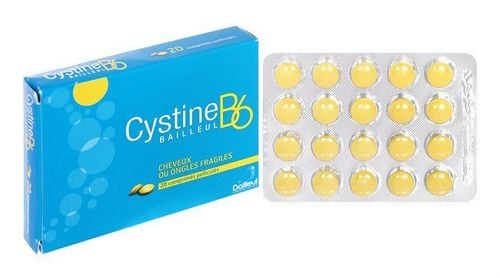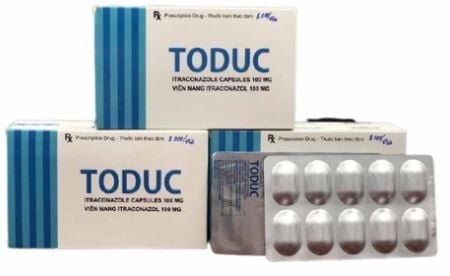This is an automatically translated article.
Itranstad 100mg drug has the main ingredient Itraconazole, which is used to treat azole fungi. The mechanism of action of the drug is to interfere with cytochrome P450 activity, reduce ergosterol synthesis and inhibit cell membrane synthesis.
1. What is Itranstad 100mg?
What is Itranstad 100mg? Itranstad medicine 100mg has the main ingredient Itraconazole, which is a drug used to treat fungi with a broader spectrum of action than ketoconazole. The mechanism of action of the drug is to interfere with the action of cytochrome P450, reduce the synthesis of ergosterol (the main sterol in the fungal cell membrane) and inhibit the formation of the cell membrane. The drug is active against fungi such as Aspergillus spp., Candida spp., Coccidioides immitis, Cryptococcus neoformans, Epidermophyton spp., Malassezia furfur, Histoplasma capsulatum, Microsporum spp.,... Itranstad is indicated in the treatment of fungi. mouth, pharynx, vagina, vulva, nails, feet or other fungi that are sensitive to itraconazole. Itraconazole is absorbed from the gastrointestinal tract, absorption is increased in the acidic environment of the stomach and is highest when taken with food. Peak plasma concentrations are reached between 1.5 and 5 hours after administration. Itraconazole is highly bound to plasma proteins and only 0.2% is circulating as free drug. The concentrations achieved in the skin, pus and tissues are much higher than those in plasma. Itraconazole is metabolised in the liver mainly by cytochrome P450, the main metabolite is hydroxy itraconazole which also has antifungal activity comparable to itraconazole. Itraconazole is excreted in bile or urine and small amounts are eliminated in the stratum corneum and hair.
2. Indications of Itranstad 100mg
Drug Itranstad 100mg is indicated for use in the following cases:
Treatment of candidiasis in the mouth - pharynx, vagina, vulva, nails, toenails Treatment of tinea versicolor. Treatment of tinea versicolor sensitive to itraconazole such as tinea pedis, systemic, inguinal or interstitial. Treatment of intrapulmonary and extrapulmonary blastomyces. Treatment of Histoplasma Blastomyces (including chronic lung disease and disseminated, non-meningococcal mycosis). Treatment of Aspergillus fungi (intrapulmonary and extrapulmonary in patients who do not respond to or are intolerant of amphotericin B). Treatment in AIDS patients to prevent recurrence of latent fungus. Prevention of fungal infections during prolonged neutropenia when conventional treatments are ineffective
3. Contraindications of Itranstad 100mg
Itranstad 100mg is contraindicated in the following cases:
Patients sensitive to itraconazole and other azoles. The patient is being treated with astemizol, terfenadine, oral triazolam, oral midazolam and cisapride. Treatment of onychomycosis in women who are pregnant or planning to become pregnant.
4. Dosage and usage of Itranstad 100mg
4.1 How to take Itranstad 100mg Capsules must be taken immediately after a meal and swallowed whole.
4.2 Dosage Adults:
Vulvar - vaginal candidiasis: orally 200mg x 2 times/day, take only 1 day or take 200mg x 1 time/day, orally for 3 days. Tinnitus: Dose 200 mg x 1 time / day, orally for 7 days. Dermatophytosis: Dose of 100 mg x 1 time / day, orally for 15 days. Oral - pharyngeal candidiasis: 100mg x 1 time/day, orally for 15 days. Patients with AIDS or neutropenia: 200mg x 1 time, orally for 15 days. Onychomycosis: Oral 200mg x 1 time/day, for 3 months. Cryptococcal meningitis: 200 mg/time x 2 times/day. Maintenance treatment with a dose of 200mg / time, 1 time a day. Histoplasmosis and Blastomyces: Oral 200 mg/time x 1-2 times/day, orally for 8 months. Cryptococcus infections (not meningitis): Oral 200 mg/time x 1 time/day for 2 months to 1 year Maintenance treatment in AIDS: Oral 200 mg/time x 1 time/day. Prophylaxis in neutropenic patients: 200mg/time, once a day. Children: The efficacy and safety of Itranstad have not been established, so it should not be used in this population.
Elderly: The dose of Itranstad in elderly patients is the same as in adults
5. Side effects of Itranstad 100mg
When using Itranstad 100mg, patients may experience the following side effects:
Frequency 10%: Gastrointestinal: Diarrhea, Nausea
Frequency 1 to 10%:
Cardiovascular: Edema, chest pain , hypertension Central nervous system: Headache, dizziness, anxiety, depression, irritability, abnormal dreams Dermatology: Skin rash, itching Endocrine and metabolic: Hypertriglyceridemia, hypokalemia Gastrointestinal: Vomiting, abdominal pain, dyspepsia, flatulence, gingivitis, stomatitis, constipation, gastritis, gastroenteritis, increased appetite Urinary: Urinary tract infection, cystitis Liver: Abnormal liver function tests, elevated liver enzymes Respiratory: Rhinitis, upper respiratory tract infection, sinusitis, cough, dyspnea, pneumonia, pharyngitis Frequency <1%: Urinalysis results abnormal often, acute generalized exanthematous pustules, adrenal insufficiency, albuminuria, alopecia, anaphylactic reactions, angioedema, arthralgia, blurred vision, arrhythmia, decreased libido, diplopia, erectile dysfunction, hyperglycemia, increased blood urea nitrogen, increased g creatine phosphokinase,...
6. Notes when using Itranstad 100mg
During the use of Itranstad 100mg, it is necessary to pay attention to some of the following issues:
Itranstad may cause central nervous system depression, impairing physical or mental capabilities. Patients should therefore be warned against performing tasks requiring alertness such as operating machinery or driving. Hearing loss: Temporary or permanent hearing loss has been reported. Hearing loss usually resolves with discontinuation of the drug, but may persist in some patients. Heart failure: Itraconazole may cause or worsen heart failure. Decreased myocardial contractility has been observed after intravenous administration. Use with caution in patients with risk factors for heart failure such as patients with COPD, renal failure, edema, ischemia, or valvular disease. Inform patients of the signs and symptoms of heart failure and monitor them carefully during treatment. If signs of heart failure occur with itraconazole, discontinue use or reassess the risk-benefit of continuing treatment. Hepatotoxicity: Cases of serious hepatotoxicity (including liver failure and death) have been reported. Hepatotoxicity has been reported in some patients without liver disease or pre-existing risk factors. Discontinue treatment if signs or symptoms of hepatotoxicity develop. Hypersensitivity: Hypersensitivity reactions have been reported in patients receiving Itranstad. Use should be discontinued and appropriate supportive care instituted if hypersensitivity reactions occur. Use with caution in patients with a history of hypersensitivity to other azoles. Neuropathy: Some cases of peripheral neuropathy have occurred in patients receiving long-term itraconazole. Monitor and discontinue use if signs or symptoms of neuropathy occur during treatment. Renal Impairment: Itranstad should be used with caution in patients with renal impairment due to limited data in this population. Dosage should be adjusted according to the patient's renal function. Pregnancy: Based on available data, an increased risk of birth defects or spontaneous abortion is not associated with short-term use of itraconazole. However, congenital abnormalities (eg, skeletal, genitourinary tract, cardiovascular and ophthalmic abnormalities, chromosomal abnormalities) have been reported during postmarketing surveillance. In general, all azole antifungals should be avoided during the first trimester of pregnancy. Lactation: Itraconazole is present in breast milk. According to the manufacturer, patients need to decide whether to continue or stop breastfeeding during treatment taking into account the risks and benefits of the drug. Drug Interactions: Concomitant use of Itranstad with some other drugs may decrease the effectiveness or increase side effects of the drug. Therefore, patients should inform their doctor about all medications, supplements, and herbs they are using for advice. In summary, Itranstad is an antifungal drug indicated in the treatment of fungal infections of the skin, nails, vulva, vagina and oropharynx. To ensure the effectiveness and safety of using the drug, patients should consult their doctor or pharmacist before use.
Follow Vinmec International General Hospital website to get more health, nutrition and beauty information to protect the health of yourself and your loved ones in your family.
Please dial HOTLINE for more information or register for an appointment HERE. Download MyVinmec app to make appointments faster and to manage your bookings easily.













